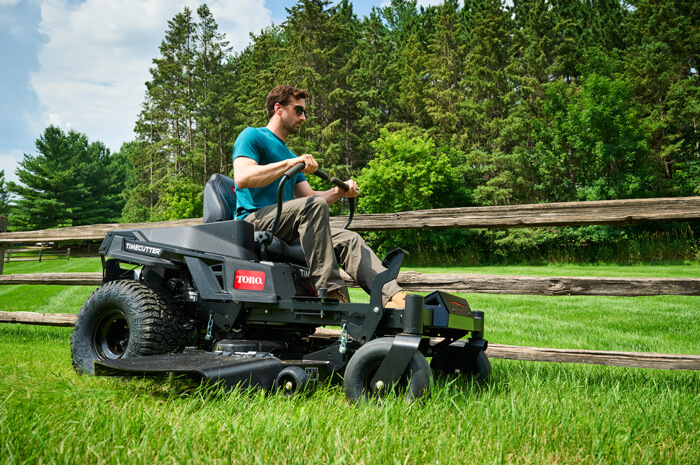
Seeing spots? Grass looking a little gray, yellow, or even red? Here are five of the most common reasons for a spotty, discolored spring lawn.
While most spring lawn diseases have fungal origins, antifungal solutions won’t solve everything. In this article you’ll discover the conditions that breed the problem, what the symptoms are, and what to do to bring your grass back to tip-top condition.
Snow Mold
What is snow mold?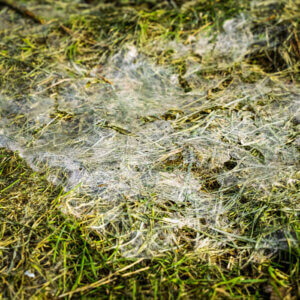
Snow mold is most common in early to late spring. When it comes to snow mold, there are two usual suspects: pink snow mold and gray snow mold. While they are less common, cottony snow mold and snow scald can also appear in early spring. These mold-based spring lawn diseases are known to show up after an extended period of snow cover, but they also appear during long periods of wet, cool and overcast weather.
What are the symptoms of snow mold?
Look for round patches of white, pink, or tan dead grass inside a subtle red-toned ring signifying pink snow mold’s presence. Pink snow mold can occur throughout the year. Gray snow mold appears in gray or tan dry patches of dead grass. A layer of stringy mycelium can sometimes be spotted in the areas where snow is still receding. Cottony snow mold will appear in irregular or circular patches with a layer of fluffy mycelium covering the leaves of grass. Finally, snow scald causes the grass to bleach but leaves behind a black stripes as a calling card.
How to treat snow mold?
Rake the affected grass and remove any excess thatch. Lightly fertilize the soil to help grass recover. If your grass remains patchy, reseed as needed.
To prevent snow mold from recurring, refrain from adding nitrogen to your lawn after the first frost. You may also want to prevent compaction to the soil by keeping snowmobiles, skis, and animals away from the area throughout winter months.
Red Thread
What is red thread?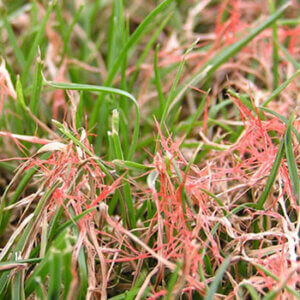
Red thread is caused by a fungus called Laetisaria fuciformis. This rust colored blight affects grass that’s stressed due to low fertilization, lack of sunlight or drought. Red thread is a common spring issue as it thrives in cool, wet conditions but it can also occur through fall.
What are the symptoms of red thread?
If you’re wondering if your lawn is affected with red thread, look for irregular or circular patches from a few inches to a foot with red threadlike elements in the grass blades.
How to treat red thread?
Collect clippings during active infection to prevent the spread of this fungus. To prevent this red thread from infecting your lawn in the future, make sure your nitrogen and potassium levels are optimized.
Fairy Rings
What is a fairy ring?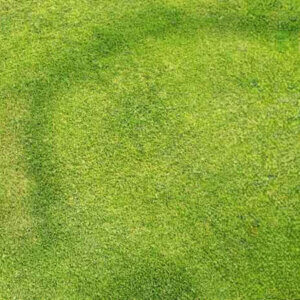
Many spring lawn diseases are tough to spot, but the fungal root of this grass issue is much more obvious. Fairy ring is the term used to describe the fungus that causes rings of mushrooms, emerald circles, or rings or arcs of dead grass inside a darker green ring. The fungi grows from organic tissue such as excess thatch. It does not kill the grass and it’s mostly an aesthetic issue.
Fairy rings are common in the spring but they can happen anytime. This spring lawn disease prefers warm, wet weather and will thrive when there is thatch accumulation.
How to treat fairy rings?
Do not apply anti-fungal treatments to fairy rings as it will not help. To mask a fairy ring issue, carefully apply fertilizer to the lighter grass within the arch or circle. Be sure and provide consistent watering to the affected area, avoid letting the grass inside the circle or arch get too dry. To prevent fairy rings, routinely remove thatch and aerate your lawn.
Necrotic Ring Spot
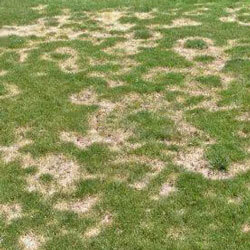 What is necrotic ring spot?
What is necrotic ring spot?
Called ring spot for short, the official moniker of this fungus is Ophiosphaerella korrae. It typically affects Kentucky bluegrass and creeping red fescue. Look for ring spot when the weather quickly turns from cool and wet to hot, drought conditions. Compacted soils also encourage this spring lawn disease.
What are the symptoms of necrotic ring spot?
Your lawn may be suffering from ring spot if you see large circles of discolored grass with healthy green grass on the interior. The affected grass starts out turning a bronze color that will fade to a straw tone. This pattern is sometimes called the “frog eye” effect. Because the fungus prefers compact soil, it is common in newly sodded lawns.
How to treat necrotic ring spot?
Prevent drain spot by reducing soil compaction, improving drainage and maintaining proper fertility. Reduce the stress on your lawn with consistent watering and by raising your mowing height. If all else fails, a fungicide can be applied.
What are the common causes of spring lawn diseases?
Winter is hard on all of us, including our grass. The fluctuations in weather and moisture can cause the grass in your lawn to become stressed and susceptible to fungus. Here are a few elements that might make your lawn more susceptible to disease.
Fungi thrive in wet conditions. Too much moisture and elements such as leaves trapping that moisture in your grass can encourage fungal diseases in your lawn. To lessen the moisture in your lawn, carefully remove fall debris before snowfall. If large drifts occur in your lawn, redistribute the snow and encourage drainage.
Fungi can also thrive when there’s an imbalance of nitrogen. Refrain from fertilizing your lawn after the last frost. The timing of your first lawn fertilization is important but depends on the area you live in and the type of grass you have.
We hope you’re now prepared to recognize, address and eventually prevent whatever spring lawn diseases might be in your neighborhood. Want to learn more about lawn health? Read our blog to learn everything you need to know about everyday lawn care basics!

